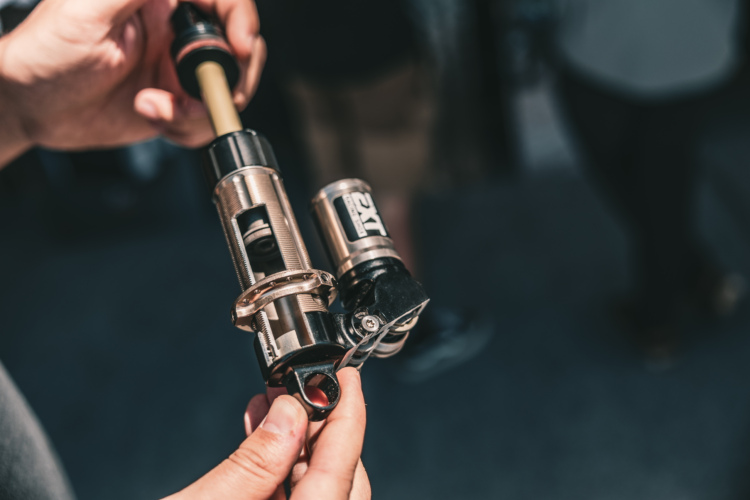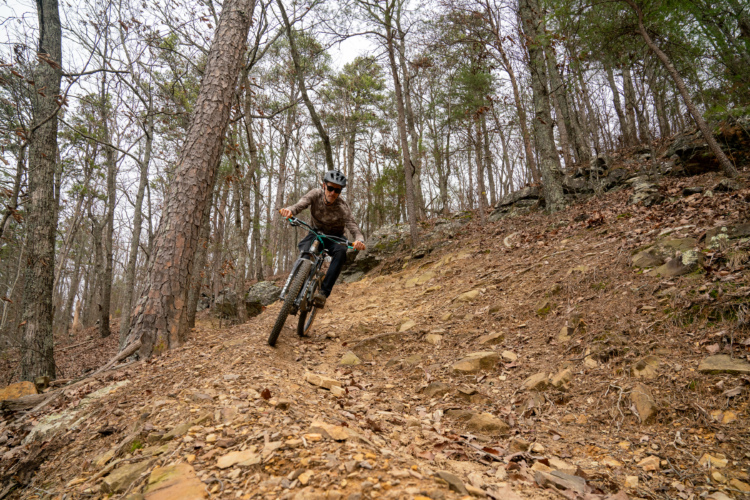Defining the term “affordable” is impossible. What is affordable for one person is astronomically expensive for another. Yet too often, when we talk about affordable mountain bikes, I think we often sell ourselves short based on price point alone.
Is “affordable” coming in below a certain arbitrary dollar threshold? Or is “affordable” getting the best performance possible for the level of expenditure that you can justify based on your budget?
[see_also id=”52902″][/see_also]
While Niner’s RIP 9 2-Star SLX build might not qualify as “affordable” for many people based on its MSRP of $3,500 (currently on sale for $2,999), I will argue below that it offers performance comparable with mountain bikes that are radically more expensive. So while the definition of “affordable” may vary wildly from person to person, I think this review will show that the RIP 9’s value is undeniable.
The New RIP: Not Like the Old RIP
The Niner RIP 9 has changed dramatically in the past year. I previously tested it in the now-defunct 130mm/125mm version, but the current rendition of the RIP features 150mm of rear travel, and either 160mm of front travel in the 29er version or 170mm in the 27.5+ version. If you’ve been paying attention you’ll have noticed that the suspension travel on the new RIP is almost exactly the same as the now-discontinued WFO 9, which I also tested previously.
[see_also id=”192137″][/see_also]
To be quite frank I find the changing of travel amounts and categories of these bikes (don’t get me started on the JET) confusing and unnecessarily complicated. From where I’m sitting, it seems that Niner’s WFO 9 never took off quite like they wanted it to, so they’re trying to capitalize on the venerable RIP 9 and JET 9 names, will simultaneously shuffling all their categories to stay modern with their suspension travel lengths.
[see_also id=”46106″][/see_also]
The takeaway? Don’t consider this new RIP 9 to be anything like the RIP you may have ridden in the past. Take your preconceptions and chuck them straight out the window, because this is an all-new beast.
Specs
Suspension Design
One thing that does stay the same is the continuation of Niner’s proven CVA suspension, which is used across all of their full suspension bikes. Standing for “Constant Varying Arc,” this design provides both pedaling efficiency and an active suspension platform at all times, according to Niner. For more information, be sure to read Niner’s in-depth explanation of CVA.
Frame and Geometry
While the RIP 9 is available in carbon, the model I tested features an aluminum frame. The rear end is Boost 148 spaced in keeping with the times, with clearance for 29×2.5″ tires or 27.5+ tires up to 3.0″. You can route a dropper post either internally (tested) or externally; the bottom bracket is a BSA threaded 73mm design; and you’ll find ISCG 05 mounts for a chain guide if you prefer to add one.
The RIP 9 features a 67-degree head tube angle with a 160mm fork and a 66.5-degree head tube angle with a 170mm fork (more on that below). The reach is 429mm with the 160 and 425 with the 170 (size medium). Wheelbase is 1178mm with a 160 and 1183mm with a 170 (size medium). Chainstays measure 440mm long across all sizes. For a detailed geometry breakdown, check out this chart:

Build Kit
The specific build I tested is the 2-Star SLX build, which is currently the only build offered on the aluminum frame. The carbon-framed models of the RIP offer many more builds to choose from. However, within the 2-Star SLX build you can choose between either 29″ wheels, or 27.5+ wheels for $300 more. I tested both configurations–more on that below.
Front suspension is handled by a RockShox Lyrik RC fork, which provides 160mm of travel for the 29″ model (170mm for 27.5+). Instead of including a flip chip in the suspension design to adjust the geometry for the varying wheel/tire sizes, Niner makes the adjustment with the fork. While this simplifies the frame, it does mean that switching wheel sizes could necessitate a change in the suspension. However, in theory it would be easier to begin with a stock 27.5+ setup with a 170mm fork and just put 29″ wheels on, thereby running your bike a bit more slacked out and with a higher BB. In my opinion, the compromise would be greater, specifically in BB height, if you were to put 27.5+ wheels on the 160mm fork. That said, according to Niner, 27.5+ wheels should be used with a 170mm fork, and 29er wheels with a 160mm fork.
The rear 150mm of suspension is delivered out by a RockShox Monarch Plus RC3 DebonAir 3-position shock. The rest of the bike is built with an 11-speed Shimano SLX drivetrain, Shimano SLX brakes, and a KS Lev SI internal dropper post. Note that the post pictured only features 100mm of drop due to a personal request to accommodate my specific fit requirements.
Niner Alloy wheels, a Maxxis Minion DHF 2.5″ tire, and a Maxxis Minion DHR II 2.4″ tire round out the build on the 29er model. On the 27.5+ model, the rims are Stan’s NoTubes NEO/ZTR Baron S1 wearing Maxxis Rekon+ 2.8″ tires.
The 29″ model weighed in at 31lbs exactly with no pedals installed, a little mud on the frame, and a bottle cage.
Out on the Trail
27.5+ Initial Test

I began my test of the new Niner RIP with 27.5+ wheels and tires instead of 29″–after all, a brand with the name “Niner” making a bike with wheels that don’t have a 9 in the name is quite a story.
To make a long story short, my first handful of rides aboard the RIP proved to me that plus tires aren’t the magic bullet that we’ve all been waiting for. While I’ve enjoyed riding plus tires in some other places in the nation in the past, I found that these 2.8″ Rekons were honestly scary in the loose-over-hardpack conditions found on our lower elevation trails in Salida, CO. In these conditions, more volume doesn’t equal more traction–instead, it equals less. In order to get purchase on these trails you need tall lugs that can cut through the loose upper layer to find a solid base below it, and the Rekons were not capable of this job.
In these conditions, the Rekons laid me on the ground several times, one crash resulting in a strained or partially torn rotator cuff that I’m still nursing. That said, the tires performed just fine in other conditions, including sand and boulders on the Western slope. But to get a more nuanced view of the new RIP, I decided to test it with standard 29″ tires.

Unrelated to the plus tires, the rear linkage developed a big clunk around the fourth ride. Unfortunately, this specific pivot couldn’t be tightened mid-ride with a standard multi-tool. Once I got the bike back to the shop, we determined that the loose bolt was deep inside the lower linkage, requiring a long-armed hex wrench to get to it. After tightening things back up, the linkage has been clunk-free.

29 Isn’t Dead Yet
That subtitle is my meager attempt at humor, yet to hear people rave about plus tires (even myself right here on this website), you’d think anything narrower than 2.8″ would be extinct by now. Yet as I dropped into my first descent aboard the new RIP 9 with a 2.5″ Minion DHF and 2.4″ Minion DHR II, I breathed a sigh of relief thanks to tall lugs digging through the loose ball bearing rocks and finding purchase beneath. While 2.8″ may be all the rage these days, I’ve been having an absolute blast lately running 2.5s on several different test bikes.

Despite the wide tire widths, the 29er rims that Niner specs aren’t of the uber-wide enduro variety–rather, they measure 25mm wide internally. Still, I found the tire profiles to be perfect with these rims. I think Niner realized that spec’ing a 2.5″ Wide Trail casing on a 30mm enduro rim would make the 2.8″ plus-size Rekon spec futile, so they wanted to differentiate the two tire/rim width sizes significantly.
Once I had 29″ wheels and tires mounted up, the RIP 9 developed a much more natural and connected-to-the-trail feel for me personally, and I was finally able to truly analyze the bike’s performance.
Descending

With 150mm of rear travel and 160 or 170mm of front travel, the RIP 9 is designed to slay the downs! I pointed the RIP at all of the gnar I could find, from the double black diamond Free Lunch trail in Grand Junction (that place is scary!), to rock gardens and feature-ridden descents on Cottonwood and Unkle Nazty locally, to some of the biggest old school kickers that I’ve hit in a long time–and through it all, the RIP delivered.
In fact, there’s nothing that I would hesitate to hit on the RIP that I wouldn’t hesitate to hit on any bike. While 150mm of rear travel might not sound like a lot after a 170mm Rocky Mountain Slayer, the Monarch Plus RC3 DebonAir provided flawless performance without complaint. Despite running through the travel multiple times, I never felt a harsh bottom out.

The bigger wheel size also helps smooth the trails and glide over wheel-sucking holes, especially when pinning straight through chundery rock gardens. Yet the RIP proved confidence-inspiring even on hucks to flat and all manner of sketchy, off-camber moves–places where 29″ wheels probably don’t make a big difference. I credit the dialed CVA suspension and slack-yet-not-too-slack geometry for saving my bacon multiple times.
I did find the 170mm Lyrik to be a bit too linear in its stroke–more ramp up in the end stroke would have been better for big hits. Adding a few clicks of compression helped, but it still wasn’t as progressive as I would have liked. I didn’t have as much issue with the 160mm Lyrik, but after learning my lesson on the 170 I did occasionally run a few clicks of compression on the 160, depending on the trail.
Climbing

Maybe it’s all in my head, but I found the RIP 9 to have more pickup and go on the climbs in the 29″ version than it did with 27.5+ tires. Initially I thought that it could be due to lower tire weight, but I dug through Maxxis’s website and it seems that the weight difference is negligible. So instead, I chalk this up to a decreased contact patch with a narrower tire.
Despite a bit of an improvement, climbing prowess was the only downside that I could find with the RIP 9. It felt a bit sluggish due to the 31-pound weight, and the 3-position lockout lever on the shock didn’t ever fully lock.
But here’s my number one complaint: this bike is spec’ed with a 32-tooth chainring and an 11-speed 11-42T rear cassette. On a 31-pound bike with 160/150mm of travel and 29er wheels, that’s a tall granny gear to be pushing around, at least for me personally. I found myself having to get off and hike the RIP more than I liked due to running out of low gear. The thing is, this is easily remedied by an 11-46T rear cassette–those four extra teeth on the big cog make a world of difference!
At the time I received the bike, the only Shimano cassettes with a 46T cog were at the XT level and above–a bit out of this price point, perhaps. But since then, Shimano has announced an 11-46T cassette at the SLX level–the perfect companion for this bike! So even if you choose to purchase the RIP 9 2-Star build before Niner updates the spec, swapping in an 11-46 cassette is an easy and affordable upgrade.
Finish Line: Value
What I find most impressive is how absolutely confidence-inspiring and capable the RIP 9 proved to be on all manner of sketchy descents… and it only retails for $3,500! While the 31-pound weight is a bit heavy, I can hardly complain about any bit of the downhill performance. Just a few years ago you had consider bikes in the $5,000 price range (or above) to get this sort of DH capability, but no longer!
Between the dialed suspension platform, the no-compromises RockShox suspension components that perform like their more expensive brethren, and bombproof wheels and tires, it seems to me that the performance gains from investing more money in a more expensive bike are minimal. Niner’s RIP 9 2-Star SLX build truly highlights the reality of diminishing returns on your mountain bike dollar investment.
MSRP: $3,500 for 29″, $3,800 for 27.5+. Both models currently on sale for $2,999 on Niner’s website.
Thanks to Niner for lending us the RIP 9 for review.
















